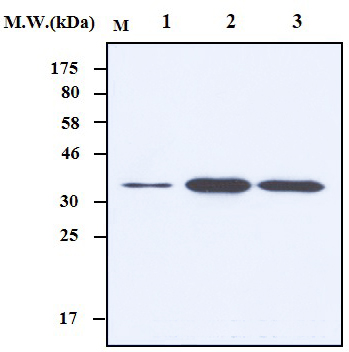anti-HES1 mAb (7H11)
Product Code:
AG-20T-0400
AG-20T-0400
Antibody Clonality:
Monoclonal
Monoclonal
Regulatory Status:
RUO
RUO
Target Species:
- Bovine (Cattle)
- Human
- Mouse
Applications:
- Enzyme-Linked Immunosorbent Assay (ELISA)
- Immunoprecipitation (IP)
- Western Blot (WB)
Shipping:
-20°C
-20°C
Storage:
-20°C
-20°C
No additional charges, what you see is what you pay! *
| Code | Size | Price |
|---|
| AG-20T-0400-C100 | 100 ug | £330.00 |
Quantity:
Prices exclude any Taxes / VAT
Stay in control of your spending. These prices have no additional charges, not even shipping!
* Rare exceptions are clearly labelled (only 0.14% of items!).
* Rare exceptions are clearly labelled (only 0.14% of items!).
Multibuy discounts available! Contact us to find what you can save.
This product comes from: Switzerland.
Typical lead time: 7-10 working days.
Contact us for more accurate information.
Typical lead time: 7-10 working days.
Contact us for more accurate information.
- Further Information
- Documents
- References
- Show All
Further Information
Alternate Names/Synonyms:
hHL; HES1; BHLHB39; bHLHb39; Hairy Homolog; Hairy-like Protein; Transcription Factor HES-1; Hairy and Enhancer of Split 1; Class B Basic Helix-Loop-Helix Protein 39
Concentration:
1mg/ml
EClass:
32160000
Form (Short):
liquid
Formulation:
Liquid. HEPES with 0.15M NaCl, 0.01% BSA, 0.03% sodium azide, and 50% glycerol.
Handling Advice:
Avoid freeze/thaw cycles.
Immunogen:
Recombinant human Hes1 protein fused to a His-tag.
Long Description:
Monoclonal Antibody. Recognizes human, mouse and rat HES1. Isotype: Mouse IgG2bkappa. Clone: 7H11. Applications: ELISA, IP, WB. Liquid. HEPES with 0.15M NaCl, 0.01% BSA, 0.03% sodium azide, and 50% glycerol. The Notch signaling pathway is important for cell-cell communication, which involve gene regulation mechanisms that control multiple cell differentiation processes during embryonic and adult life. It critically influences cell proliferation, differentiation, and apoptosis in metazoans. The hairy and enhancer of split (HES) family is a basic helix-loop-helix (bHLH) type trancriptional repressor and acts as Notch effectors by negatively regulating expression of downstream target genes such as tissue-specific transcription factors. HES-1 is an upstream negative regulator of REST expression. Silencing of the transcriptional repressor REST is required for terminal differentiation of neuronal and beta-cells. Recent integrative genomic analyses on HES/HEY family suggest that HES1 and HES3 are target genes of the embryonic stem cell-specific network of transcription factors, and that HES1, HES5, HEY1, HEY2 and HEYL are target genes of Notch signaling pathway.
Package Type:
Plastic Vial
Product Description:
The Notch signaling pathway is important for cell-cell communication, which involve gene regulation mechanisms that control multiple cell differentiation processes during embryonic and adult life. It critically influences cell proliferation, differentiation, and apoptosis in metazoans. The hairy and enhancer of split (HES) family is a basic helix-loop-helix (bHLH) type trancriptional repressor and acts as Notch effectors by negatively regulating expression of downstream target genes such as tissue-specific transcription factors. HES-1 is an upstream negative regulator of REST expression. Silencing of the transcriptional repressor REST is required for terminal differentiation of neuronal and beta-cells. Recent integrative genomic analyses on HES/HEY family suggest that HES1 and HES3 are target genes of the embryonic stem cell-specific network of transcription factors, and that HES1, HES5, HEY1, HEY2 and HEYL are target genes of Notch signaling pathway.
Purity:
>95% (SDS-PAGE)
Specificity:
Recognizes human, mouse and rat HES1.
Transportation:
Non-hazardous
UNSPSC Category:
Primary Antibodies
UNSPSC Number:
12352203
Use & Stability:
Stable for at least 1 year after receipt when stored at -20°C.
Documents
References
Mechanoregulation of h2-calponin gene expression and the role of notch signaling: W. Jiang, et al.; J. Biol. Chem. 289, 1617 (2014) | CRMP5 controls glioblastoma cell proliferation and survival through Notch-dependent signaling: A. Moutal, et al.; Cancer Res. 75, 3519 (2015)



